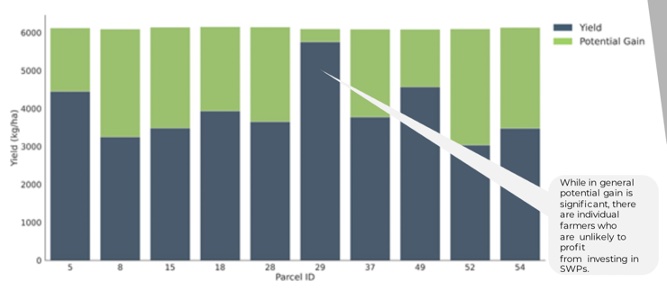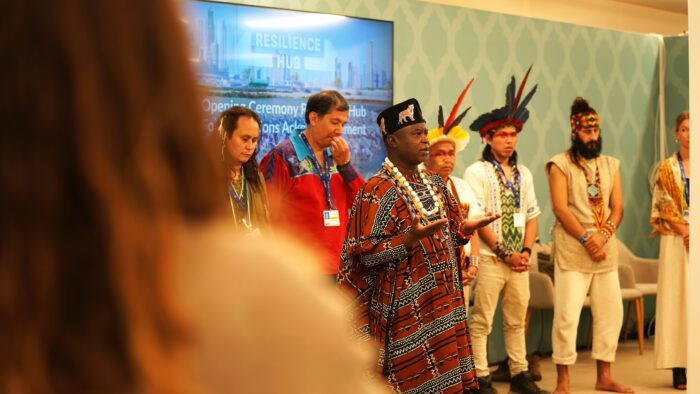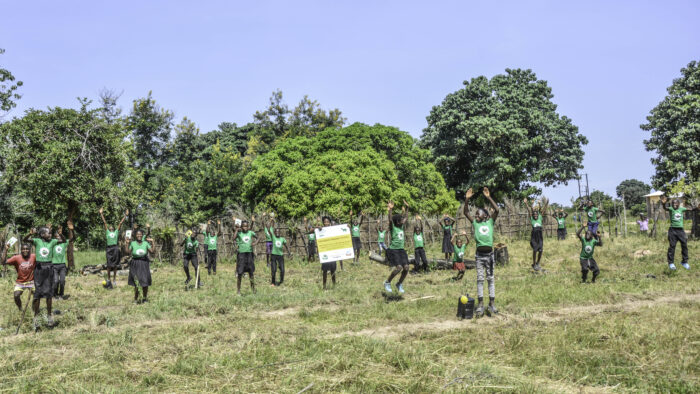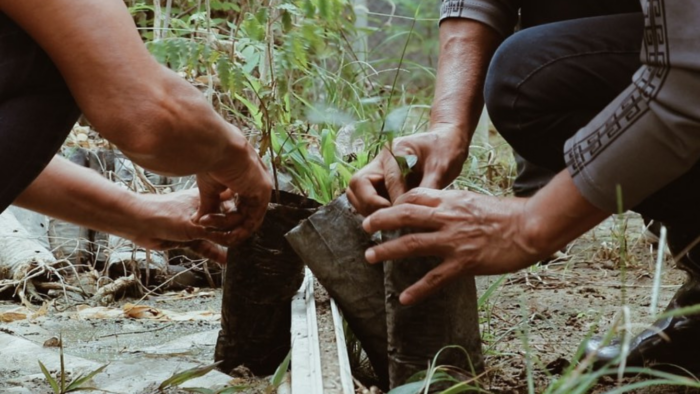The industrial agricultural sector contributes significantly to runaway global climate change. It consumes 30% of total energy supply and generates 20% of global greenhouse gas emissions.¹ Yet, this sector also offers livelihood to 40% of the world’s population, and sustainable agricultural growth has the potential to provide a leg-up to those living under the poverty line.² The question then is — how do we create an agricultural food system that supports the people who rely on it, while also building climate resilience?
Efficiency for Access explored this question during a session co-led with the Global Resilience Partnership and Stockholm Resilience Centre at the COP27 Resilience Hub in Sharm El-Sheikh, Egypt. ‘Emerging innovations and their potential to transform mitigation and adaptation efforts in agriculture’ brought together speakers from CLASP, Energy Saving Trust, REEEP, the Stockholm Resilience Centre and the World Economic Forum to identify innovations that could help build greater resilience within our food systems.
Our speakers included Sean de Cleene from the World Economic Forum; Richa Goyal, Senior Research Specialist at Energy Saving Trust; Makena Ireri, Director of Clean Energy Access at CLASP; Eva Kelly Oberender, CEO of REEEP; Laura Pereira, Associate Professor at the Global Change Institute at Witwatersrand University and Researcher at the Stockholm Resilience Centre; and Felicity Tolley, Senior Programme Manager of International Energy Access at Energy Saving Trust, as facilitator. We had a transparent conversation on what works, what doesn’t and what steps we need to take in order to see the kinds of results we want for a more resilient, sustainable and just world.
The event highlighted four opportunities that provide promising paths for further exploration, as well as four challenges that remain complex issues for which we need further innovative thinking.
Opportunities
1. The technologies and knowledge needed to build adaption and resilience are available. We must sharpen what tools we have through the use of reliable data.
Through the lens of clean energy access, solar technologies like a solar water pump could increase farmers’ crop yields by 25%. For some farmers, though, a solar water pump may not add significant benefit, while other solutions may be more suitable [Table 1]. Alongside technical innovations, innovative finance has the potential to transform renewable energy projects. A blended finance facility led by REEEP in Nepal is focused on financing local projects aims to mainstream commercial lending for small-scale renewable energy projects, helping the country to transition from grants and subsidies to credit-based financing. However, we need to understand the cultural context and local needs before applying innovations, like results-based financing or loan guarantees, across the board. The technologies and business models already exist, but concise data is needed to maximise impact.
In collaboration with other finance and clean energy stakeholders, Efficiency for Access published the State of the Off-Grid Solar Market Trends report, which shines a light on the latest research and findings from the off-grid solar market. You can discover more of our research on off-grid appliances at the Efficiency for Access publications library.

2. Embedding solar technologies within a regenerative agriculture (RA) context can help contribute to climate change mitigation, enhance farmer resiliency, improve global nutrition and empower local communities.
Regenerative organic farming emphasises the importance of soil health and includes practices such as cover cropping, crop rotation, holistic grazing of animals, water harvesting, contour cropping, no use of synthetic fertilisers, pesticides or herbicides. Coupled with solar-powered technologies, RA can de-risk payments for a solar appliance by cushioning farmers against reduced yields. It can increase yields over conventional agriculture and reduces costs of inputs. It can also enhance crop resiliency in the face of shocks such as pest attacks, offering a cleaner and more sustainably abundant alternative to conventional agriculture’s dangerous overuse of pesticides. Furthermore, carbon sequestration opportunities from RA farms can be combined with GHG mitigation benefits from using solarised technologies to have greater levels of mitigation impacts. Read more from this case study on farmers using RA practices in Kenya.
3. Building networks of cooperation that are deeply rooted in local communities and their unique needs can help facilitate feedback loops that benefit people and the environment.
One of the most frequent messages that came up throughout COP27 was the emphasis on local knowledge. Not every mechanism or innovation may be applicable in every context given unique cultural or geographic needs; instead, we must centre local, indigenous voices who already have the knowledge to build greater resilience. Networks of cooperation that are deeply rooted in community are some of the most effective ways to truly understanding an ecosystem. Read about this case study from the Western Cape of South Africa which focuses on the reintegration of forgotten local indigenous foods into local foodways through networks of collaboration between farmers, restaurants and food consumers.
4. A call to action — We need creative thinking on how to bring these innovations into cross-pollination with each other. Bridging these innovations will be key to creating an ecosystem that is resilient, just and sustainable.
While each financial, technological, social and agricultural innovation listed above holds enormous potential for impact, creating a cross-sectoral ‘innovation ecosystem’ is what will elevate, expand and deepen true transformational change. We are already seeing synergies between innovations — between social network building and financial mechanisms, or regenerative agriculture and solar-powered technologies — but we need to get even more innovative. We need creative thinking around policy mechanisms, partnership and cooperative models, data and monitoring, blended finance mechanisms and de-risking transitions. If we hope to break out from proof of concept and expand sustainable, just impact, this moment demands collective creative thinking.
Barriers
1. Falling into and remaining in siloes could hinder progress. Implementing ‘systems thinking’ needs to be more than a buzzword that holds empty promises but little action.
The solutions here lie in robust and productive methods of communication and follow-through on commitments. Stakeholders should hold each other accountable in delivering top-down and bottom-up change simultaneously.
2. Innovative financial mechanisms, while they do exist, are still difficult to access, and few really focus on scaling deep at a local level since perceived risk is high and financial returns are less profitable.
Both public and private financing, as well as both local and international investors, must take more risks and value social return on investment highly if the world’s poorest people are to build resilience while improving their livelihoods.
3. Holistic inclusivity, especially around gender and those living below the poverty line, remains far behind where it should be for a true just transition in the food and agriculture space to take place.
In a recent Efficiency for Access report on inclusivity in the off-grid appliances sector, we found that the typical solar appliance user in the Global South is a man in his early forties, connected to the grid, employed with at least a secondary education, and not below the poverty line. These preliminary findings suggest that the off-grid appliances sector still has a way to go in order to reach those who are most marginalised. Solutions that are designed with inclusivity in mind will provide further reaching impact that reduces the number of people left behind in the transition to net zero.
4. Trust is missing between institutions and individuals, and it will take time and patience to reforge connection and sustainable cooperation.
Planning interventions should take into account existing power dynamics at micro- and macro- cultural levels. Community engagement is vital, beyond making the solutions available to ensuring their effective uptake and impact. You can read about our community-building efforts in a recent consumer awareness-raising campaign we ran in Machakos County, Kenya.
Conclusion
The tools for effective transformation that can help guide us towards the global climatic changes we need already exist. What we do need is the collective willpower, creativity and funding to build innovative ecosystems that support locally-based, sustainable, resilient, just, cross-collaborative innovation. This comes from understanding and implementing the opportunities, as well as taking into account the inevitable challenges that come from working in complex ecosystems. However, by having an honest look at the challenges and incorporating them into our work, we can transmute these challenges into opportunities that enable even stronger, more resilient change.
Sources
- https://www.usaid.gov/energy/powering-agriculture/opportunity
- https://ideas.repec.org/a/eee/wdevel/v31y2003i12p1959-1975.html
Originally published here.


